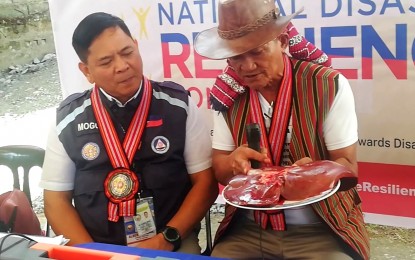
OFFERING. Albert Mogol, Office of Civil Defense (OCD)-Cordillera director and Cordillera Disaster Risk Reduction Management Council (CDRRMC) chairman, listens to a “mambunong” (native priest) explaining the symbolism of the bile from a butchered pig offering during the opening of the observance of National Disaster Resilience Month on Monday (July 10, 2023). The CDRRMC urged local government units and individuals to be ready for drought due to f El Niño and the possible occasional strong rains that might hit the region. (PNA photo by Liza T. Agoot)
BAGUIO CITY – The Cordillera Disaster Risk Reduction Management Council (CDRRMC) has again urged the residents to prepare against the various effects of El Niño which the weather bureau said would last until 2024.
"We ask local government units (LGUs) and the people to be prepared for the effect on food, water, energy, health and public security," Albert Mogol, Office of Civil Defense (OCD)-Cordillera director and CDRRMC chairman, said on Monday during the opening program of the National Disaster Resilience Month at the OCD office here.
He said they have reactivated the El Niño Task Force formed three years ago and put in place additional focus aside from actions related to ensuring food security.
"The preparations should not only be for the government, but individually, in our homes, we have to be prepared," Mogol added.
During the same event, Engr. Hilario Esperanza, Senior Weather Specialist of the Philippine Atmospheric, Geophysical and Astronomical Services Administration (PAGASA), said the Cordillera Administrative Region (CAR) will have normal rainfall from July to September but by October, rainfall is forecast to be below normal or from 41 to 80 millimeters (mm).
In November, rainfall will be near 41 ml while zero rains are expected during the last month of the year.
"The El Niño's effect will be felt until the first quarter of 2024 so we have to be ready," Esperanza said.
Mogol said that when there is an El Niño, other problems arise such as food shortage due to damage in agriculture as a result of the dry spell.
Health problems also arise not to mention security issues and energy crises with hydroelectric power plants operating at low production capacity or worse, temporarily shut down.
"All these are taken into consideration in the expanded roadmap for addressing the effect of El Niño, Mogol said.
Cordillera's readiness
Aside from the activation of the task force, Leo Quintilla, regional director of the Department of Social Welfare and Development (DSWD) in CAR, urged the public to adopt water-saving measures in their homes and carry out rain-harvesting.
"Pwede tayong mag-recycle ng tubig pambuhos sa comfort room at pandilig ng halaman (We can recycle water for use in the toilet or in watering the plants," he said in an earlier interview.
Quintilla added that they maintain a stockpile of about 40,000 family food packs in regional warehouses aside from those that have been prepositioned with the 69 local government units, for easy access in times of calamity.
The Department of Agriculture, which is part of the El Niño Task Force, also advised farmers to plant drought-resistant crops during the period to prevent being affected by the dry spell. (PNA)
